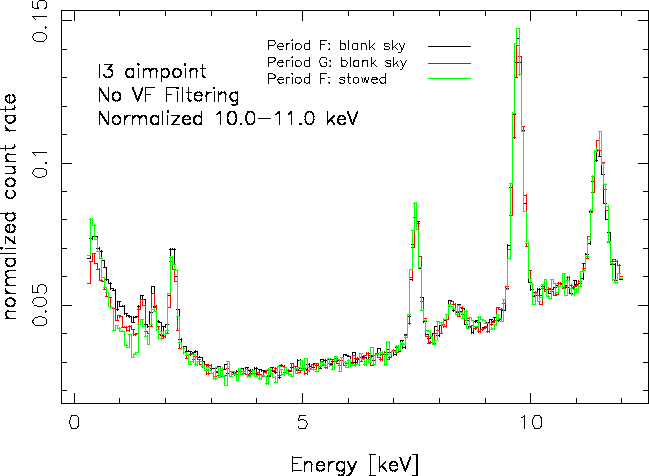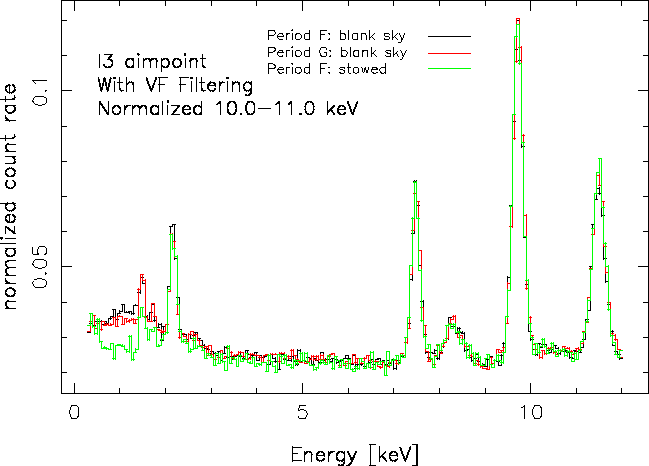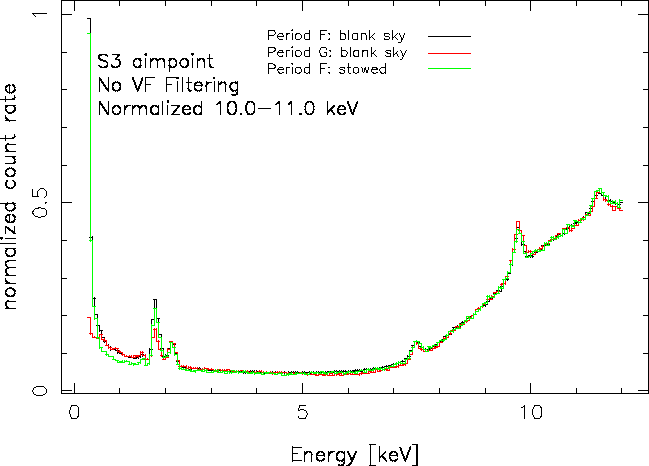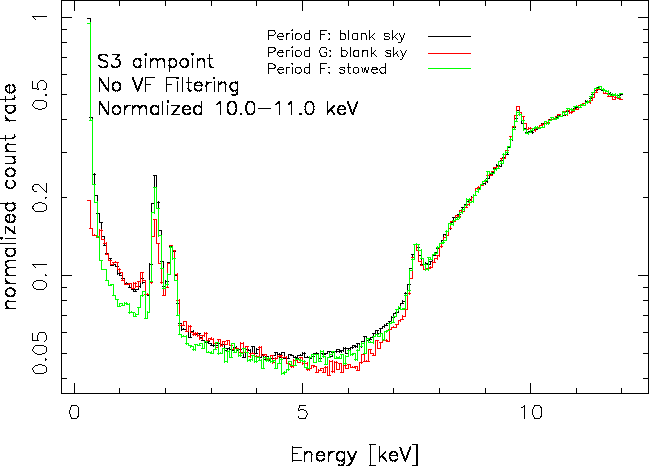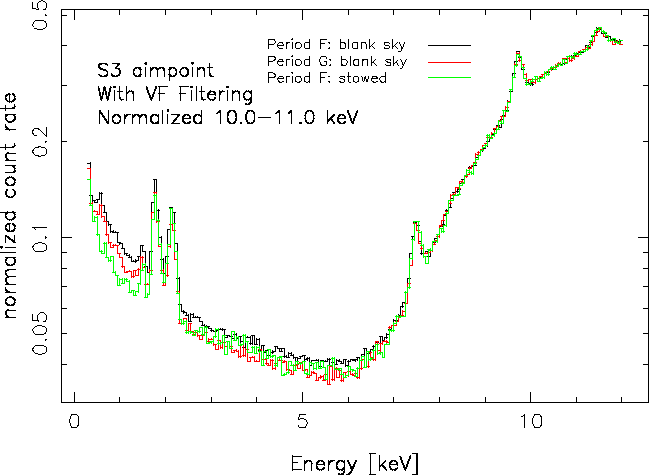CalDB 4.7.5.1 Public Release Notes
Includes CalDB 4.7.5 Public Release
Public Release Date: 20 July 2017
The CalDB 4.7.5.1 upgrade is not relevant to Standard Processing, and hence has not been installed therein.
I. INTRODUCTION
CalDB 4.7.5.1 is an upgrade to the Chandra CalDB, which includes the following items:
- ACIS Background Event Lists Group G
- ACIS BKGRND Groups A-F PI/PHA DATATYPE Modifications
- HRC-S QEU v8 Header Corrections
For the CIAO 4.9 / CalDB 4.7.5.1 release notes see How CalDB 4.7.5.1 Affects Your Analysis.
II. SUMMARY OF CHANGES
A. ACIS Background Event Lists Group G
| Location: | $CALDB/data/chandra/acis/bkgrnd/ |
| Filenames: | With ACIS-S in focal plane: acis2sD2012-01-01bkgrnd_ctiN0001.fits *** See NOTICE below. *** acis3sD2012-01-01bkgrnd_ctiN0001.fits acis5sD2012-01-01bkgrnd_ctiN0001.fits *** See NOTICE below. *** acis6sD2012-01-01bkgrnd_ctiN0001.fits acis7sD2012-01-01bkgrnd_ctiN0001.fits acis8sD2012-01-01bkgrnd_ctiN0001.fits With ACIS-I in focal plane: acis0iD2012-01-01bkgrnd_ctiN0001.fits acis1iD2012-01-01bkgrnd_ctiN0001.fits acis2iD2012-01-01bkgrnd_ctiN0001.fits acis3iD2012-01-01bkgrnd_ctiN0001.fits acis6iD2012-01-01bkgrnd_ctiN0001.fits *** NOTICE below about this file *** |
![[IMPORTANT]](../../imgs/important.png)
![[New]](../../imgs/new.gif) (28 Jul 2017)
A user in the community has pointed out an error in the 6i background dataset:
(28 Jul 2017)
A user in the community has pointed out an error in the 6i background dataset:
- acis6iD2012-01-01bkgrnd_ctiN0001.fits
wherein
the exposure time is only half as long as that of the ACIS-0, 1, 2, and 3 files, but nearly
the same number of events. This would make the ACIS-6 BKGRND rate nearly twice that of the other
four chips. Looking at the event lists as an image reveals a couple of artificial "hot spots"
which resulted from a bug in the event-cloning routine used to regenerate background events
in place of removed source positions in the blank-field files. USERS SHOULD AVOID USING THIS FILE!
A replacement for it will be generated soon, for the next CalDB upgrade release.
ADDITIONALLY: The ACIS Calibration team has also identified issues with the two additional files above, namely:
- acis2sD2012-01-01bkgrnd_ctiN0001.fits
- acis5sD2012-01-01bkgrnd_ctiN0001.fits
These three files will be repaired and replaced in the next CalDB release, expected in mid August.
The ACIS Calibration Team has released the next group (G) of CTI-corrected blank-sky background event lists. These have been compiled from datasets accumulated over the years 2012 through 2015, and hence they are accurate for observations taken during that time period. The new Group G BKGRND event lists become effective as of 2012-01-01T00:00:00, and will be selected automatically from CalDB for observations taken on or after that date. See your observation's DATE-OBS in your level 2 events file headers.
The new ACIS BKGRND files cover the same chip and detector configurations as applicable for the previous set (Group F, effective 2009 through 2011). BKGRND files for the non-CTI-corrected BI chip cases (for graded data mode imaging observations) will be released at a later date.
See the technical details section below for more information on the new background datasets.
PIPELINES/TOOLS AFFECTED:
CIAO script blanksky, which uses acis_bkgrnd_lookup to search for these BKGRND event lists, is used to tailor the background to specific observations.
THREADS AFFECTED:
Analysing the ACIS Background with the "Blank-Sky" Files
B. ACIS BKGRND Groups A-F PI/PHA DATATYPE Modifications
| Location: | $CALDB/data/chandra/acis/bkgrnd/ |
| Filenames: | Group A: acis6sD1999-08-12bkgrndN0003.fits acis7iD1999-08-12bkgrndN0004.fits acis7sD1999-08-12bkgrndN0003.fits Group B: acis0iD1999-09-16bkgrndN0003.fits acis1iD1999-09-16bkgrndN0003.fits acis2iD1999-09-16bkgrndN0003.fits acis2sD1999-09-16bkgrndN0003.fits acis3iD1999-09-16bkgrndN0003.fits acis3sD1999-09-16bkgrndN0003.fits acis5sD1999-09-16bkgrndN0003.fits acis6iD1999-09-16bkgrndN0003.fits acis6sD1999-09-16bkgrndN0003.fits acis7iD1999-09-16bkgrndN0003.fits acis7sD1999-09-16bkgrndN0003.fits acis8sD1999-09-16bkgrndN0003.fits acis9sD1999-09-16bkgrndN0003.fits Group C: acis0iD2000-01-29bkgrnd_ctiN0006.fits acis0iD2000-01-29bkgrndN0004.fits acis1iD2000-01-29bkgrnd_ctiN0006.fits acis1iD2000-01-29bkgrndN0004.fits acis1sD2000-01-29bkgrnd_ctiN0006.fits acis1sD2000-01-29bkgrndN0006.fits acis2iD2000-01-29bkgrnd_ctiN0006.fits acis2iD2000-01-29bkgrndN0004.fits acis2sD2000-01-29bkgrnd_ctiN0006.fits acis2sD2000-01-29bkgrndN0006.fits acis3iD2000-01-29bkgrnd_ctiN0006.fits acis3iD2000-01-29bkgrndN0004.fits acis3sD2000-01-29bkgrnd_ctiN0006.fits acis3sD2000-01-29bkgrndN0006.fits acis5sD2000-01-29bkgrnd_ctiN0002.fits acis5sD2000-01-29bkgrndN0006.fits acis6iD2000-01-29bkgrnd_ctiN0006.fits acis6sD2000-01-29bkgrnd_ctiN0006.fits acis6sD2000-01-29bkgrndN0006.fits acis7iD2000-01-29bkgrnd_ctiN0002.fit s acis7iD2000-01-29bkgrndN0005.fits acis7sD2000-01-29bkgrnd_ctiN0002.fits acis7sD2000-01-29bkgrndN0006.fits acis8sD2000-01-29bkgrnd_ctiN0002.fits acis8sD2000-01-29bkgrndN0006.fits Group D: acis0D2000-12-01bgstow_ctiN0005.fits acis0iD2000-12-01bkgrnd_ctiN0005.fits acis0iD2000-12-01bkgrndN0003.fits acis1D2000-12-01bgstow_ctiN0005.fits acis1iD2000-12-01bkgrnd_ctiN0005.fits acis1iD2000-12-01bkgrndN0003.fits acis1sD2000-12-01bkgrnd_ctiN0006.fit s acis1sD2000-12-01bkgrndN0002.fits acis2D2000-12-01bgstow_ctiN0003.fits acis2iD2000-12-01bkgrnd_ctiN0005.fits acis2iD2000-12-01bkgrndN0003.fits acis2sD2000-12-01bkgrnd_ctiN0006.fits acis2sD2000-12-01bkgrndN0006.fits acis3D2000-12-01bgstow_ctiN0005.fits acis3iD2000-12-01bkgrnd_ctiN0005.fits acis3iD2000-12-01bkgrndN0003.fits acis3sD2000-12-01bkgrnd_ctiN0006.fits acis3sD2000-12-01bkgrndN0006.fits acis5D2000-12-01bgstow_ctiN0002.fits acis5D2000-12-01bgstowN0004.fits acis5sD2000-12-01bkgrnd_ctiN0002.fits acis5sD2000-12-01bkgrndN0006.fits acis6D2000-12-01bgstow_ctiN0005.fits acis6iD2000-12-01bkgrnd_ctiN0005.fits acis6iD2000-12-01bkgrndN0003.fits acis6sD2000-12-01bkgrnd_ctiN0006.fits acis6sD2000-12-01bkgrndN0006.fits acis7D2000-12-01bgstow_ctiN0002.fits acis7D2000-12-01bgstowN0004.fits acis7iD2000-12-01bkgrnd_ctiN0002.fits acis7iD2000-12-01bkgrndN0004.fits acis7sD2000-12-01bkgrnd_ctiN0002.fits acis7sD2000-12-01bkgrndN0006.fits acis8iD2000-12-01bkgrnd_ctiN0002.fits acis8iD2000-12-01bkgrndN0004.fits acis8sD2000-12-01bkgrnd_ctiN0003.fits acis8sD2000-12-01bkgrndN0007.fits Group E: acis0D2005-09-01bgstow_ctiN0002.fits acis0iD2005-09-01bkgrnd_ctiN0005.fits acis1D2005-09-01bgstow_ctiN0002.fits acis1iD2005-09-01bkgrnd_ctiN0005.fits acis2D2005-09-01bgstow_ctiN0002.fits acis2iD2005-09-01bkgrnd_ctiN0005.fits acis2sD2005-09-01bkgrnd_ctiN0005.fits acis2sD2005-09-01bkgrndN0005.fits acis3D2005-09-01bgstow_ctiN0002.fits acis3iD2005-09-01bkgrnd_ctiN0005.fits acis3sD2005-09-01bkgrnd_ctiN0005.fits acis3sD2005-09-01bkgrndN0005.fits acis5D2005-09-01bgstow_ctiN0002.fits acis5sD2005-09-01bkgrnd_ctiN0005.fits acis5sD2005-09-01bkgrndN0005.fits acis6D2005-09-01bgstow_ctiN0002.fits acis6iD2005-09-01bkgrnd_ctiN0005.fits acis6sD2005-09-01bkgrnd_ctiN0005.fits acis6sD2005-09-01bkgrndN0005.fits acis7D2005-09-01bgstow_ctiN0002.fits acis7iD2005-09-01bkgrnd_ctiN0005.fits acis7sD2005-09-01bkgrnd_ctiN0005.fits acis7sD2005-09-01bkgrndN0005.fits acis8sD2005-09-01bkgrnd_ctiN0005.fit s acis8sD2005-09-01bkgrndN0005.fits Group F: acis0D2009-09-21bgstow_ctiN0002.fits acis0iD2009-09-21bkgrnd_ctiN0003.fits acis1D2009-09-21bgstow_ctiN0002.fits acis1iD2009-09-21bkgrnd_ctiN0003.fits acis2D2009-09-21bgstow_ctiN0002.fits acis2iD2009-09-21bkgrnd_ctiN0003.fits acis2sD2009-09-21bkgrnd_ctiN0003.fits acis3D2009-09-21bgstow_ctiN0002.fits acis3iD2009-09-21bkgrnd_ctiN0003.fits acis3sD2009-09-21bkgrnd_ctiN0003.fits acis5D2009-09-21bgstow_ctiN0002.fits acis5sD2009-09-21bkgrnd_ctiN0003.fits acis5sD2009-09-21bkgrndN0002.fits acis6D2009-09-21bgstow_ctiN0002.fits acis6iD2009-09-21bkgrnd_ctiN0003.fits acis6sD2009-09-21bkgrnd_ctiN0003.fits acis7D2009-09-21bgstow_ctiN0002.fits acis7sD2009-09-21bkgrnd_ctiN0003.fits acis7sD2009-09-21bkgrndN0002.fits acis8sD2009-09-21bkgrnd_ctiN0003.fits |
The Chandra Helpdesk and the CXC CIAO Documentation team (CIAODOC) have requested a change to the ACIS BKGRND event lists data specification, in particular that the PHA and PI columns be changed from data type "integer" (I2) to data type longword (I4), retroactive to all existing as well as future BKGRND files. The new Group G files already conform to this spec; however the 123 pre-existing files do not. Hence these older BKGRND event files have been modified in this CalDB release to accommodate. In addition, several BKGRND files from early in the mission have been found to lack the appropriate header keywords for the ACIS subarray spec, namely FIRSTROW ( = 1) and NROWS (= 1024). These keywords and values have been added to any files that were missing them. Because changing the PI and PHA data types inherently changes the BINTABLEs themselves, all filenames have been reset with a higher version number, and each new file is listed above. The Chandra CalDB manifest file for the ACIS BKGNRDs, located in ${CALDB}/data/chandra/acis/bkgrnd/acis_bkgrnd_manifest.txt, has been appropriately updated.
C. HRC-S QEU v8 Header Corrections
The files in question were released in CalDB 4.7.4 on 04 May 2017. They are listed in the CalDB 4.7.4 release notes.
The CalDB Manager has been alerted that the latest HRC-S QEU files released in CalDB 4.7.4 (released May 04, 2017) are all missing the "TELESCOP" keyword from their file headers, resulting in their listings in the corresponding INDEX file column being left blank, instead of reading "CHANDRA" as they ought to. The above files have been corrected and are being re-released with CalDB 4.7.5.1.
The missing keyword did not affect the new files being selected in the ARDLIB from CalDB; This is a minor change that only affects the index listing, not its function. Hence the HRC branch index file version is being updated, but the above QEU file versions are not being changed.
III. TECHNICAL DETAILS
A. ACIS Background Event Lists Group G
Period G will cover observations taken from 2012-01-01T00:00:00 to The present, for the time being. The focal plane temperature for these data (FP_TEMP) is -120C. The background rate was low and relatively flat for this period. See Figure 1 below; The background rate is anticorrelated with the solar activity over the same period. Most recently (since late 2015) the background has increased steadily as the solar activity has decreased.
The datasets include ACIS-I and ACIS-S observations in VFAINT mode. Events flagged during VF processing can be removed using the events filter 'status=0'. If the VF-flagged events are not removed, the result is equivalent to FAINT mode events.
Currently, only CTI-corrected files are provided. Non-CTI-corrected versions for ACIS-S3 and S1, appropriate for graded mode observations, will be provided at a later date.

Fig. 1: ACIS blank-sky background levels for S2 and S3 respectively, with ACIS-S in the focal
plane, over the life of the mission.
The plots below compare the period G aimpoint spectra to the corresponding period F blank sky background spectra and the period F ACIS-stowed background spectra. All plots use a linear energy scale. To make it easier to see any structure, the count rate scales are presented both for linear and logarithmic scaling. The count rates were normalized by scaling to the period F stowed using 10-11 keV (chosen to avoid the prominent fluorescent lines below 10 keV and above 11 keV). In each case, versions with VF flagged events screened out ('With VF Filtering') and with VF flagged events left in ('No VF Filtering' - equivalent to FAINT mode) are provided. For the ACIS-I aimpoint background spectra, see figs 2-5 below.
The most noticeable differences are seen in the S3 aimmpoint (figs 6-9 below) with or without VF filtering. For no VF filtering, the period F and period G blank sky, and period F stowed agree well above ~8 keV. The blank sky data also agree well below ~5 keV; the blank sky rates are above the stowed rates because residual sky background sources are included in the blank sky data. From ~5 to ~7 keV, there is an anomalous difference between period F and period G of ~10%-20% which will need to be explored in future work. For the S3 aimpoint with VF filtering, the rates agree well above ~7 keV, but there may be a few % to ~10% for ~2 to ~7 keV. Again, this remains to be investigated.
